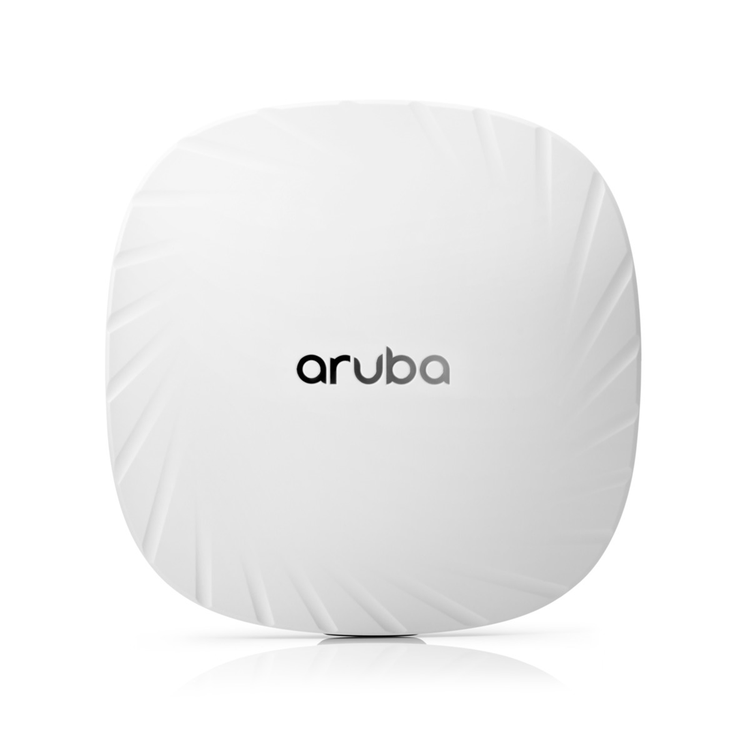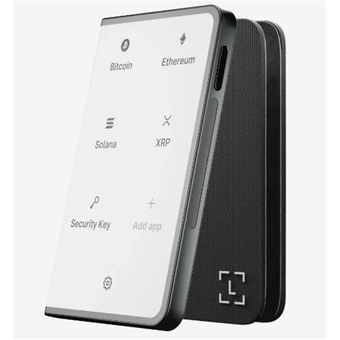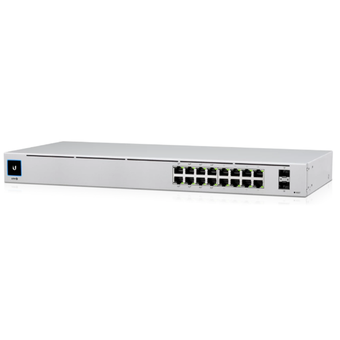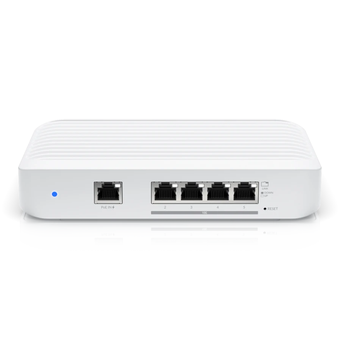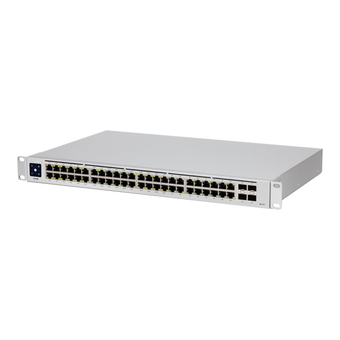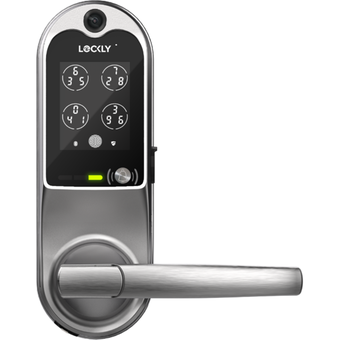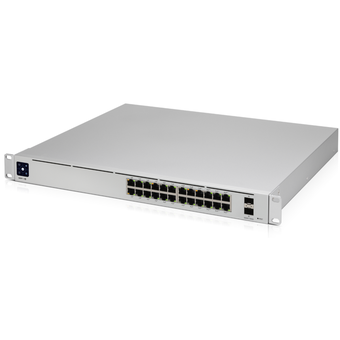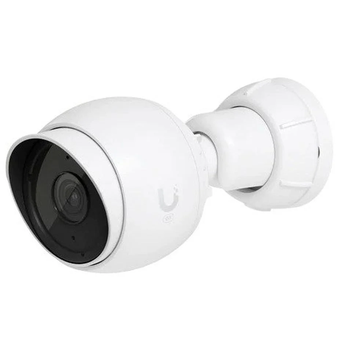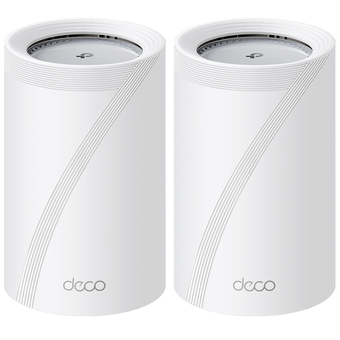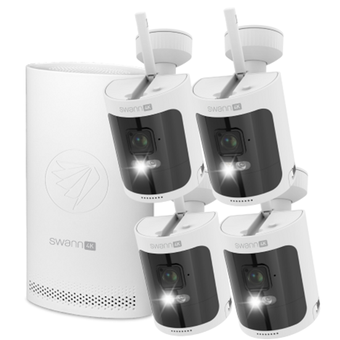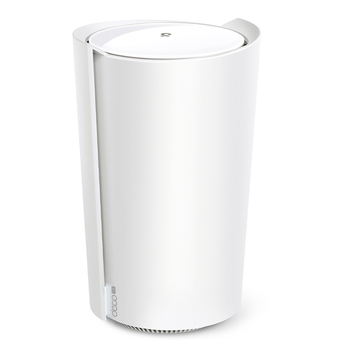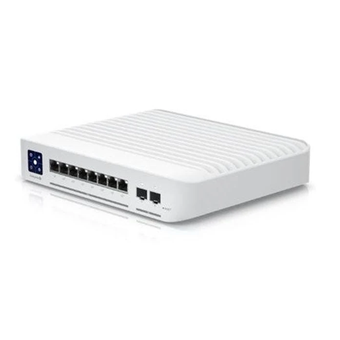Aruba AP-505 (RW) Unified AP
These affordable Wi-Fi 6 access points provide high-performance connectivity for any organization experiencing growing numbers of mobile, IoT and mobility requirements. With a maximum real-world aggregate data rate of 1.49 Gbps (HE80/HE20), they deliver the speed and reliability needed for venues and workplaces such as schools, midsize offices and retailers.
- 1.49 Gbps maximum real-world speed (HE80/HE20)
- WPA3 and Enhanced Open security
- Built-in technology that resolves sticky client issues for Wi-Fi 6 and Wi-Fi 5 devices
- OFDMA and MU-MIMO for enhanced multi-user efficiency
- IoT-ready Bluetooth 5 and Zigbee support
INCREDIBLE EFFICIENCY
The 500 Series APs are also designed to optimize user experience by maximizing Wi-Fi efficiency and dramatically reducing airtime contention between clients. Features include Orthogonal frequency-division multiple access (OFDMA), bi-directional multi-user MIMO and cellular optimization. With up to 2 spatial streams (2SS) and 80MHz channel bandwidth (HE80), the 500 Series provides groundbreaking wireless capabilities for budget-conscious deployments. Read the Multi-User 802.11ax white paper for further information.
Advantages of OFDMA
This capability allows Aruba's APs to handle multiple Wi-Fi 6 capable clients on each channel simultaneously, regardless of device or traffic type. Channel utilization is optimized by handling each transaction via smaller sub-carriers or resource units (RUs), which means that clients are sharing a channel and not competing for airtime and bandwidth.
Aruba Air Slice™ for Extended Application Assurance
Initially, APs in controller-less mode (Instant) can provide SLA-grade performance by allocating radio resources, such as time, frequency, and spatial streams, to specific traffic types. By combining Aruba's Policy Enforcement Firewall (PEF) and Layer 7 deep packet inspection (DPI) to identify user roles and applications, the APs will dynamically allocate the bandwidth needed. Non-Wi-Fi 6 clients can also benefit. Air Slice™ for APs uses Aruba Central for management. Controller-based APs will be supported in a future software release.
Multi-user MIMO (MU-MIMO)
The 500 Series AP supports downlink MU-MIMO just like WiFi 5 (802.11ac Wave 2) APs. The added benefit is the ability to multiply the number of clients that can now send traffic, thus optimizing client-to-AP spatial stream diversity.
Wi-Fi 6 and MU-MIMO aware client optimization
Aruba's patented AI-powered ClientMatch technology eliminates sticky client issues by placing Wi-Fi 6 capable devices on the best available AP. Session metrics are used to steer mobile devices to the best AP based on available bandwidth, types of applications being used and traffic type - even as users roam.
Aruba Advanced Cellular Coexistence (ACC)
This feature uses built-in filtering to automatically minimize the impact of interference from cellular networks, distributed antenna systems (DAS), and commercial small cell or femtocell equipment.
Intelligent Power Monitoring (IPM)
Aruba APs continuously monitor and report hardware energy consumption. They can also be configured to enable or disable capabilities based on available PoE power - ideal when wired switches have exhausted their power budget.
Green AP energy efficiency
Aruba Wi-Fi 6 APs utilize analytics from NetInsight to automatically transition in and out of a sleep mode based on client density. Learn more in the Green AP At-A-Glance.
IOT PLATFORM CAPABILITIES
Like all Aruba Wi-Fi 6 APs, the 500 Series includes an integrated Bluetooth 5 and 802.15.4 radio (for Zigbee support) to simplify deploying and managing IoT-based location services, asset tracking services, security solutions and IoT sensors. This allows organizations to leverage the 500 Series as an IoT platform, which eliminates the need for an overlay infrastructure and additional IT resources.
Target Wake Time (TWT)
Ideal for IoTs that communicate infrequently, TWT establishes a schedule for when clients need to communicate with an AP. This helps improve client power savings and reduces airtime contention with other clients.
ARUBA SECURE INFRASTRUCTURE
The Aruba 500 Series includes components of Aruba's 360 Secure Fabric to help protect user authentication and wireless traffic. Select capabilities include:
WPA3 and Enhanced Open
Support for stronger encryption and authentication is provided via the latest version of WPA for enterprise protected networks. Enhanced Open offers seamless new protection for users connecting to open networks where each session is automatically encrypted to protect user passwords and data on guest networks.
WPA2-MPSK
MPSK enables simpler passkey management for WPA2 devices - should the Wi-Fi password on one device or device type change, no additional changes are needed for other devices. Requires ClearPass Policy Manager.
VPN Tunnels
In Remote AP (RAP) and IAP-VPN deployments, the Aruba 500 Series can be used to establish a secure SSL/IPSec VPN tunnel to a Mobility Controller that is acting as a VPN concentrator.
Trusted Platform Module (TPM)
For enhanced device assurance, all Aruba APs have an installed TPM for secure storage of credentials and keys, and boot code.
SIMPLE AND SECURE ACCESS
To simplify policy enforcement, the Aruba 500 Series uses Aruba's policy enforcement firewall (PEF) feature to encapsulate all traffic from the AP to the Mobility Controller (or Gateway) for end-to-end encryption and inspection. Policies are applied based on user role, device type, applications, and location. This reduces the manual configuration of SSIDs, VLANs and ACLs. PEF also serves as the underlying technology for Aruba Dynamic Segmentation.
HIGH-DENSITY CONNECTIVITY
Each 500 Series AP provides connectivity for a maximum of 256 associated clients per radio (512 in total). In real-world scenarios, the maximum recommended client density is dependent on environmental conditions.
FLEXIBLE OPERATION AND MANAGEMENT
A unique feature of Aruba APs is the ability to operate in either controllerless (Instant) or controller-based mode.
Controller-less (Instant) mode
In controllerless mode, one AP serves as a virtual controller for the entire network. Learn more about Instant mode in this technology brief.
Mobility Controller mode
For optimized network performance, roaming and security, APs tunnel all traffic to a mobility controller for centrally managed traffic forwarding and segmentation, data encryption, and policy enforcement. Learn more in the ArubaOS datasheet.
Management options
Available management solutions include Aruba Central (cloud-managed) or Aruba AirWave - a multi-vendor on-premises management solution. For large installations across multiple sites, APs can be factory-shipped and can be activated with Zero Touch Provisioning through Aruba Central or AirWave. This reduces deployment time, centralizes configuration, and helps manage inventory.
Download data sheet: https://www.arubanetworks.com/assets/ds/DS_AP500Series.pdf
TECHNICAL SPECIFICATIONS
AP type
Indoor, dual radio, 5GHz and 2.4GHz 802.11ax 2x2 MIMO
5GHz radio
Two spatial stream Single User (SU) MIMO for up to 1.2Gbps wireless data rate with individual 2SS HE80 802.11ax client devices, or with two 1SS HE80 802.11ax MU-MIMO capable client devices simultaneously
2.4GHz radio
Two spatial stream Single User (SU) MIMO for up to 574Mbps (287 Mbps) wireless data rate with individual 2SS HE40 (HE20) 802.11ax client devices or with two 1SS HE40 (HE20) 802.11ax MU-MIMO capable client devices simultaneously
Maximum number of associated client devices
Up to 256 associated client devices per radio
Maximum number of BSSIDs
16 BSSIDs per radio
Supported frequency bands (country-specific restrictions apply)
- 2.400 to 2.4835GHz
- 5.150 to 5.250GHz
- 5.250 to 5.350GHz
- 5.470 to 5.725GHz
- 5.725 to 5.850GHz
Available channels
Dependent on configured regulatory domain
Supported radio technologies
- 802.11b: Direct-sequence spread-spectrum (DSSS)
- 802.11a/g/n/ac: Orthogonal frequency-division multiplexing (OFDM)
- 802.11ax: Orthogonal frequency-division multiple access (OFDMA) with up to 8 resource units
Supported modulation types
- 802.11b: BPSK, QPSK, CCK
- 802.11a/g/n: BPSK, QPSK, 16-QAM, 64-QAM, 256-QAM (proprietary extension)
- 802.11ac: BPSK, QPSK, 16-QAM, 64-QAM, 256-QAM, 1024-QAM (proprietary extension)
- 802.11ax: BPSK, QPSK, 16-QAM, 64-QAM, 256-QAM, 1024-QAM
802.11n high-throughput (HT) support
HT20/40
802.11ac very high throughput (VHT) support
VHT20/40/80
802.11ax high efficiency (HE) support
HE20/40/80
Supported data rates (Mbps)
802.11b: 1, 2, 5.5, 11
802.11a/g: 6, 9, 12, 18, 24, 36, 48, 54
802.11n: 6.5 to 300 (MCS0 to MCS15, HT20 to HT40), 400 with 256-QAM
802.11ac: 6.5 to 867 (MCS0 to MCS9, NSS = 1 to 2, VHT20 to VHT80), 1,083 with 1024-QAM
802.11ax (2.4GHz): 3.6 to 574 (MCS0 to MCS11, NSS = 1 to 2, HE20 to HE40)
802.11ax (5GHz): 3.6 to 1,201 (MCS0 to MCS11, NSS = 1 to 2, HE20 to HE80)
802.11n/ac/ax packet aggregation
A-MPDU, A-MSDU
Transmit power
Configurable in increments of 0.5 dBm
Maximum (aggregate, conducted total) transmit power (limited by local regulatory requirements)
2.4 GHz band: +21 dBm (18dBm per chain)
5 GHz band: +21 dBm (18 dBm per chain)
Note: conducted transmit power levels exclude antenna gain. For total (EIRP) transmit power, add antenna gain.
OTHER INTERFACES
E0: Ethernet wired network port (RJ-45)
Auto-sensing link speed (10/100/1000BASE-T) and MDI/MDX
POE-PD: 48Vdc (nominal) 802.3af/at POE (class 3 or 4)
802.3az Energy Efficient Ethernet (EEE)
DC power interface
12Vdc (nominal, +/- 5%), accepts 2.1mm/5.5mm center-positive circular plug with 9.5mm length
USB 2.0 host interface (Type A connector)
Capable of sourcing up to 1A / 5W to an attached device
Bluetooth Low Energy (BLE5.0) and Zigbee (802.15.4) radio
BLE: up to 7dBm transmit power (class 1) and -93dBm receive sensitivity (1Mbps)
Zigbee: up to 6dBm transmit power and -96dBm receive sensitivity
Integrated vertically polarized omnidirectional antenna with roughly 30 degrees downtilt and peak gain of 3.3dBi
Visual indictors (two multi-color LEDs)
For System and Radio status
Reset button
Factory reset, LED mode control (normal/off)
Serial console interface
Proprietary, micro-B USB physical jack
Security slot
Kensington security slot
POWER SOURCES AND POWER CONSUMPTION
Power Sources
The AP supports direct DC power and Power over Ethernet
When both DC and POE power sources are available, DC power takes priority over POE
Power sources are sold separately; see the 500 Series Ordering Guide for details
When powered by DC or 802.3at (class 4) POE, the AP will operate without restrictions.
When powered by 802.3af (class 3) POE and with the IPM feature disabled, the AP will disable the USB port. In the same configuration but with IPM enabled, the AP will start up in unrestricted mode, but may dynamically apply restrictions depending on the POE budget and actual power. The feature restrictions and order can be programmed.
Maximum (worst-case) power consumption (without / with a USB device attached)
DC powered: 8.9W / 14.2W.
POE powered (802.3at): 11.0W / 16.5W.
POE powered (802.3af): 11.0W / 13.5W.
This assumes that up to 5W is supplied to the attached USB device.
Maximum (worst-case) power consumption in idle mode
4.3W (DC) or 6.2W (POE).
Maximum (worst-case) power consumption in deep-sleep mode
1.7W (DC) or 3.7W (POE).
ENVIRONMENTAL SPECIFICATIONS
Operating conditions
Temperature: 0C to +50C / +32F to +122F
Humidity: 5% to 93% non-condensing
AP is plenum rated for use in air-handling spaces
ETS 300 019 class 3.2 environments
Storage and transportation conditions
Temperature: -40C to +70C / -40F to +158F
Humidity: 5% to 93% non-condensing
ETS 300 019 classes 1.2 and 2.3 environments
RELIABILITY
Mean Time Between Failure (MTBF)
1.3Mhrs (148yrs) at +25C operating temperature.
As an international traveller you are entitled to bring a certain amount/value of goods that are free of Customs duty and exempt Goods and Services tax (GST) into New Zealand. This is called your duty free allowance and personal goods concession. It is important to review these for any purchases you make on The Mall.
Your duty free allowance entitles you to bring into New Zealand the following quantities of alcohol products free of customs duty and GST provided you are over 17 years of age. You do need to be 18 years or over to purchase.
- Up to six bottles (4.5 litres) of wine, champagne, port or sherry or
- Up to twelve cans (4.5 litres) of beer
- And three bottles (or other containers) each containing not more than 1125ml of spirits, liqueur, or other spirituous beverages
Goods other than alcohol and tobacco, whether purchased overseas or purchased duty free in New Zealand, that have a combined total value not exceeding NZ$700 may also be brought as part of your personal goods concession.
When travelling overseas there are legal limits on the amount of duty free alcohol and other goods you can take with you. These amounts will vary depending on the country you are flying into. We always recommend you check the latest limits and exemptions.
Your order can be picked up at an Auckland Airport Collection Point. There is one in departures and one at arrivals in the international terminal. Alternatively, if you are arriving between 11pm and 6am you will be able to collect your order from our lockers. See map
Please bring your order confirmation email and your passport. If you are collecting from lockers you will have been sent an email with your access code, be sure to have this on you in order to collect your order.
If you’re departing Auckland Airport, we recommend that you come to the Auckland Airport Collection Point at least 60 minutes before your flight. If you miss your pickup time or your flight details have changed please let us know as soon as possible.
When you collect your order you will have the opportunity to inspect the items and sign for them.
If you need to return an item, our Collection Point team are there to help you. If you are collecting after hours please return the item to your locker and our team will be in touch as soon as possible. You may also like to view our Returns & refunds which provides information on how this works and outlines the individual retailer's returns and refunds policies.
After Hours Collections
If your order needs to be collected after the Auckland Airport Collection Point desk is closed, your order will be placed in the lockers next to the desk. All the details you will need to collect your order will be provided in your Order Confirmation and Ready to Collect Email.











